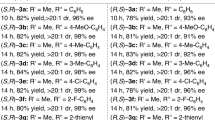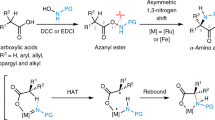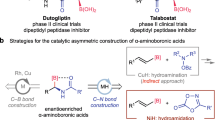Abstract
Reliable, selective and environmentally friendly chemical transformations are crucial to the development of new therapeutics and the design of novel materials. Chiral catalysts that can be easily prepared and used to obtain organic molecules of high enantiomeric purity are critical to modern chemical synthesis1. The development of protecting groups that shield reactive functionalities has also proved indispensable in the preparation of complex biologically active molecules2. Here we present a chiral catalyst that promotes the enantioselective protection of a secondary alcohol as one of the most commonly used protected forms of an alcohol: a silyl ether. The catalyst is a small, simple molecule that can be prepared in three steps from commercial materials without the need for rigorously controlled conditions. Enantioselective silylations are performed with commercial silyl chlorides and produce yields of up to 96 per cent at an enantiomeric ratio of up to 98:2. Chiral catalysts for selective formation of commonly used protecting groups such as silyl ethers should significantly enhance the ability of chemical synthesis to deliver, in a more practical and efficient manner, important organic molecules.
This is a preview of subscription content, access via your institution
Access options
Subscribe to this journal
Receive 51 print issues and online access
$199.00 per year
only $3.90 per issue
Buy this article
- Purchase on Springer Link
- Instant access to full article PDF
Prices may be subject to local taxes which are calculated during checkout



Similar content being viewed by others
References
Thayer, A. Chiral catalysts. Chem. Eng. News 83, 40–48 (2005)
Kocienski, P. J. Protecting Groups. (Thieme, Stuttgart, 2005)
Jacobsen, E. N., Pfaltz, A. & Yamamoto, H. (eds) Comprehensive Asymmetric Catalysis (Springer, Berlin, 1999)
Corey, E. J. & Cheng, X-M. The Logic of Chemical Synthesis (Wiley, New York, 1989)
Corey, E. J. & Venkateswarlu, A. Protection of hydroxyl groups as tert-butyldimethylsilyl derivatives. J. Am. Chem. Soc. 94, 6190–6191 (1972)
Isobe, T., Fukuda, K., Araki, Y. & Ishikawa, T. Modified guanidines as chiral superbases: the first example of asymmetric silylation of secondary alcohols. Chem. Commun., 243–244 (2001)
Rendler, S., Auer, G. & Oestreich, M. Kinetic resolution of chiral secondary alcohols by dehydrogenative coupling with recyclable silicon-stereogenic silanes. Angew. Chem. Int. Edn 44, 7620–7624 (2005)
Jarvo, E. R. & Miller, S. J. Asymmetric acylation in Comprehensive Asymmetric Catalysis (Supplement 1) (eds Jacobsen, E. N., Pfaltz, A. & Yamamoto, H.) 189–206 (Springer, Berlin, 2004)
Miller, S. J., Copeland, G. T., Papaioannou, N., Horstmann, T. E. & Ruel, E. M. Kinetic resolution of alcohols catalyzed by tripeptides containing the N-alkylimidazole substructure. J. Am. Chem. Soc. 120, 1629–1630 (1998)
Sculimbrene, B. & Miller, S. J. Discovery of a catalytic asymmetric phosphorylation through selection of a minimal kinase mimic: A concise total synthesis of D-myo-inositol-1-phosphate. J. Am. Chem. Soc. 123, 10125–10126 (2001)
Evans, J. W., Fierman, M. B., Miller, S. J. & Ellman, J. A. Catalytic enantioselective synthesis of sulfinate esters through the dynamic resolution of tert-butanesulfinyl chloride. J. Am. Chem. Soc. 126, 8134–8135 (2004)
Myers, A. G., Hammond, M. & Wu, Y. An improved preparation of highly enantiomerically enriched (R)-(+ )-4-tert-butyl-di-methylsiloxy-2-cyclopenten-1-one. Tetrahedr. Lett. 37, 3083–3086 (1996)
Gutmann, V. The Donor–Acceptor Approach to Molecular Interactions (Plenum, New York, 1978)
Denmark, S. E., Beutner, G. L., Wynn, T. & Eastgate, M. D. Lewis base activation of Lewis acids: catalytic enantioselective addition of silyl ketene acetals to aldehydes. J. Am. Chem. Soc. 127, 3774–3789 (2005)
Kelly, T. R., Zhao, C. & Bridger, G. J. A bisubstrate reaction template. J. Am. Chem. Soc. 111, 3744–3745 (1989)
Jarvo, E. R., Copeland, G. T., Papaioannou, N., Bonitatebus, P. J. & Miller, S. J. A biomimetic approach to asymmetric acyl transfer catalysis. J. Am. Chem. Soc. 121, 11638–11643 (1999)
Taylor, M. S. & Jacobsen, E. N. Asymmetric catalysis by chiral hydrogen-bond donors. Angew. Chem. Int. Edn 45, 1520–1543 (2006)
Traverse, J. F., Zhao, Y., Hoveyda, A. H. & Snapper, M. L. Proline-based N-oxides as readily available and modular chiral catalysts. Enantioselective reactions of allyltrichlorosilane with aldehydes. Org. Lett. 7, 3151–3154 (2005)
Vedejs, E. & Jure, M. Efficiency in nonenzymatic kinetic resolution. Angew. Chem. Int. Edn 44, 3974–4001 (2005)
Porter, J., Traverse, J. F., Hoveyda, A. H. & Snapper, M. L. Enantioselective synthesis of arylamines through Zr-catalyzed addition of dialkylzincs to imines. Reaction development by screening of parallel libraries. J. Am. Chem. Soc. 123, 984–985 (2001)
Cole, B. M. et al. Chiral catalyst discovery through ligand diversity. Ti-catalyzed enantioselective addition of TMSCN to meso epoxides. Angew. Chem. Int. Edn 35, 1668–1671 (1996)
Hoveyda, A. H. in Handbook of Combinatorial Chemistry (eds Nicolaou, K. C., Hanko, R. & Hartwig, W.) 991–1016 (Wiley-VCH, Weinheim, 2002)
Vasbinder, M. M., Jarvo, E. R. & Miller, S. J. Incorporation of peptide isosteres into enantioselective peptide-based catalysts as mechanistic probes. Angew. Chem. Int. Edn 40, 2824–2827 (2001)
Bassindale, A. R. & Stout, T. The interaction of electrophilic silanes (Me2SiX, X = ClO4, I, CF3SO3, Br, Cl) with nucleophiles. The nature of silylation mixtures in solution. Tetrahedr. Lett. 26, 3403–3406 (1985)
Blackmond, D. Kinetic aspects of nonlinear effects in asymmetric catalysis. Acc. Chem. Res. 33, 402–411 (2000)
Acknowledgements
We are grateful to our colleague S. J. Miller for discussions and a critical reading of the manuscript. This work was supported by the United States National Institutes of Health, Institute of General Medical Sciences (grant to A.H.H. and M.L.S.). We are grateful to J. F. Traverse for experimental assistance.
Author information
Authors and Affiliations
Corresponding authors
Ethics declarations
Competing interests
Reprints and permissions information is available at www.nature.com/reprints. The authors declare no competing financial interests.
Supplementary information
Supplementary Data
This file contains supplementary methods, references, figures and tables. (PDF 719 kb)
Rights and permissions
About this article
Cite this article
Zhao, Y., Rodrigo, J., Hoveyda, A. et al. Enantioselective silyl protection of alcohols catalysed by an amino-acid-based small molecule. Nature 443, 67–70 (2006). https://doi.org/10.1038/nature05102
Received:
Accepted:
Issue Date:
DOI: https://doi.org/10.1038/nature05102
This article is cited by
-
Collective total synthesis of C4-oxygenated securinine-type alkaloids via stereocontrolled diversifications on the piperidine core
Nature Communications (2022)
-
Diastereoselective desymmetric 1,2-cis-glycosylation of meso-diols via chirality transfer from a glycosyl donor
Nature Communications (2020)
-
Broad-spectrum kinetic resolution of alcohols enabled by Cu–H-catalysed dehydrogenative coupling with hydrosilanes
Nature Communications (2017)
-
Enantioselective acyl transfer catalysis by a combination of common catalytic motifs and electrostatic interactions
Nature Communications (2016)
-
Parts-per-million level loading organocatalysed enantioselective silylation of alcohols
Nature Communications (2015)
Comments
By submitting a comment you agree to abide by our Terms and Community Guidelines. If you find something abusive or that does not comply with our terms or guidelines please flag it as inappropriate.



